‘Senua’s Saga: Hellblade II’ Is a Movie Masquerading as a Game. It Falls Short on Both

“All monsters were once men.”
Repeated frequently throughout Senua’s Saga: Hellblade II, this phrase works not just as a useful thematic through-line, but as a question: Can you, the player, see the monster within yourself?
More from Rolling Stone
How Valkyrae's Imaginary Relationship With a Killer Clown Became a Streaming Hit
'It Helped Me Embody Someone Else': How 'Cyberpunk 2077' Helped Gene Park Battle Cancer
Senua’s Saga: Hellblade II, the newest game from Xbox Games Studios and Ninja Theory, would like you to consider that question, but the answer is a foregone conclusion. As a psychological journey through a violent world, it leans on violence, both metaphorically and literally, as a means to liberate its characters from the torment they’ve inflicted on themselves and others. But it’s also asking for you to find another way, without ever really presenting one. The trauma induced by violence will beget more violence, and the player doesn’t really have a choice in the matter.
Although it’s billed as an action-adventure game, Senua’s Saga is essentially an interactive movie. Utilizing motion capture and cutting-edge graphics, it’s presented as a cinematic on-rails experience. From the opening cutscene, which transitions directly into gameplay, players will follow a heavily scripted narrative that requires minimal effort to control. Presented in a super wide aspect ratio and featuring no on-screen clutter like health bars or mini-maps, it’s fully committed to the visual language of cinema to tell the story, as the camera seamlessly pulls in behind the character to play, then out and around her when it’s time to let go. Although the distinction is minimal as the lack of traditional video game stats and overlays urges you to remain locked in, as you’ll never know when things will intensify. And they will get intense.
Set in Tenth-century Iceland, the story centers on Senua, a Pict warrior brought to the country’s shores as a slave to the Northmen, where she must free the locals from brutal captivity. Under the subjugation of a stronger neighboring tribe, the people she encounters aren’t just being used for labor, but as human sacrifice to appease the roaming giants that decimate the lands. But nothing is quite as it seems. Remember: all monsters were once men.
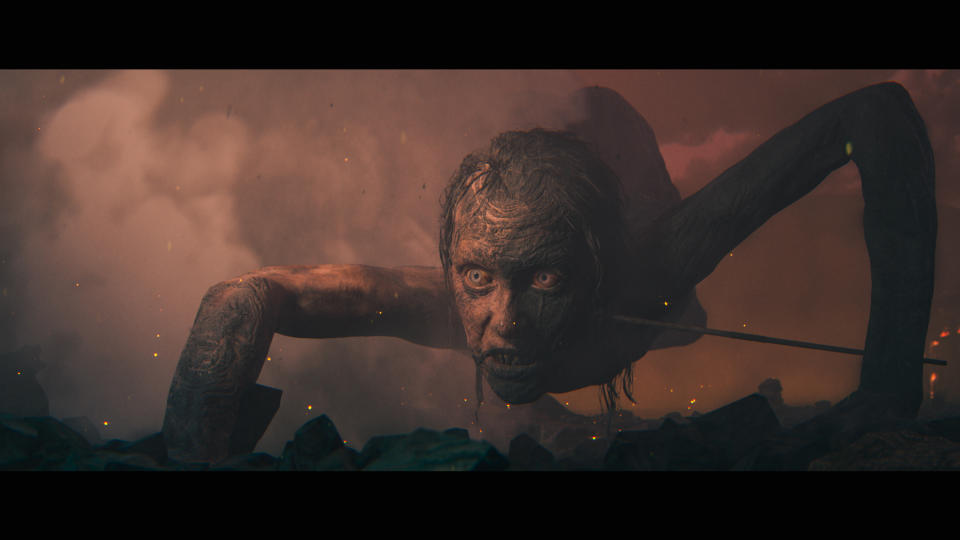
It’s a dour setup, especially given for those who hoped for a better outcome for Senua following the first game (2017’s Senua’s Sacrifice), wherein she overcame her own self-doubt and lifelong trauma to end in a healthier place. The original game was lauded for its depiction of psychosis, a condition that afflicted its protagonist who was deemed cursed for her hallucinations and disconnect from reality. Abused by her father and unraveling following the death of her lover, Senua trekked to the depths of Hel to put her inner demons to rest and atone for her failures, coming to terms with the fact that her “curse” was truly a part of her, and by accepting herself she could go on to help others accept themselves.
Whereas the first game toyed nebulously with the idea that the Senua’s apparitions might’ve been the result of her condition, the sequel is more literal. There are monsters plaguing the land, and we know how people react to them. Unlike its predecessor, which featured no secondary characters for Senua to speak with outside of the voices in her own head, Senua’s Saga has a full cast to interact with. From the slaver who dragged her to the Icelandic shore to the warrior tribesmen that she aids along the way, everyone is firmly committed to the fact there are giants, although some wiggle room is left open to interpretation as the beats themselves are characterized as people whose personal traumas led them down more monstrous paths.
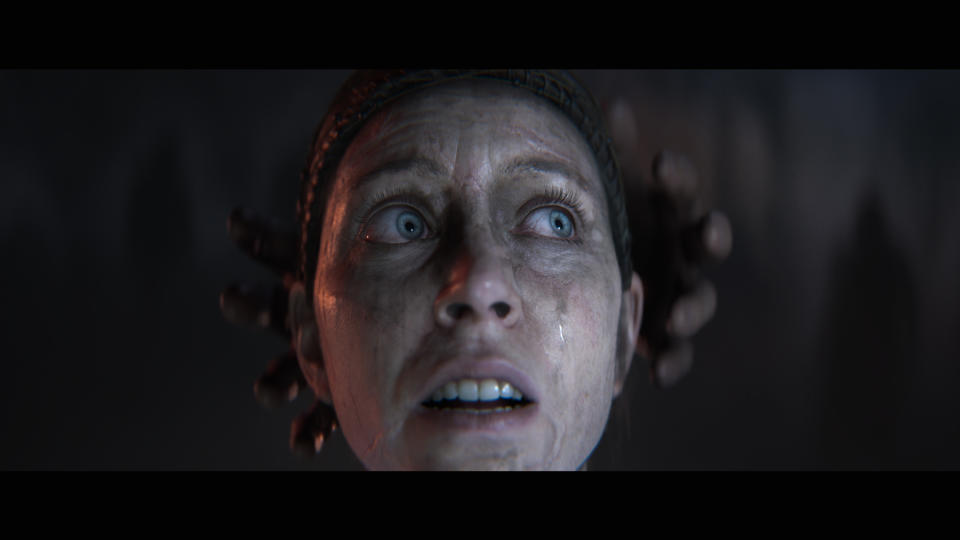
Senua’s psychosis does still play a prominent role, as the “Furies” and “darkness” within her claw at her, belittling and casting doubt on her every decision through extremely effective use of binaural sound design. With a good pair of headphones — which the game urges you to wear in a note at the start — the voices in Senua’s head whisper and float ethereally from ear to ear with great effect. The sound design is exceptional all around, with extended sequences led entirely by audio as Senua often finds herself lost in dark woods and caves, with only haunting sound to guide her from the eldritch horrors at every turn.
But the presence of secondary characters changes the way players interact with the story to its detriment. By forcing Senua on an introspective journey the first time around, the original game (which was brief at only seven hours) leaned into the debilitating fatigue and confusion of psychosis. The psychological horror of endless mental torment, punctuated by jump-scare apparitions and an overwhelming sense of isolation, made Senua’s Sacrifice a harrowing experience that ended with relief as the chaos within calmed in the end.
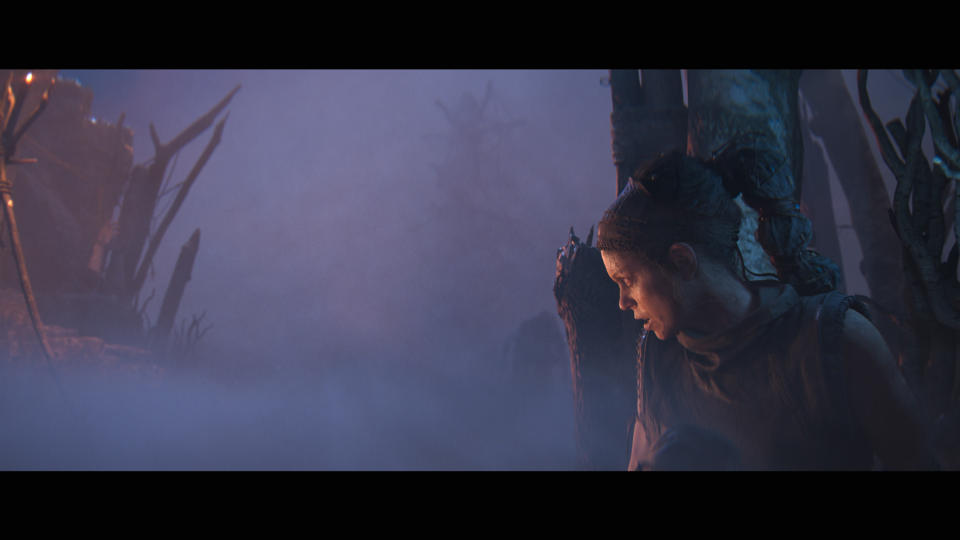
Conversely, the sequel has a lot less to do with Senua’s voices in any meaningful way. Yes, it’s clear that the trials of self-doubt never truly end, but knowing that there was a sense of resolution in the first game means that her inner turmoil plays more as an inconvenient window-dressing for a character that’s already become sure of herself and is focusing on helping others do the same.
What results is a less focused story, which feels strange given how tightly regimented the experience is supposed to be otherwise. There are only three types of gameplay in Senua’s Saga in between cut scenes: walking along paths during dialog, environmental puzzle solving, and combat. Puzzles mostly amount to finding the exact position in space where two seemingly unrelated things (like stray tree branches and rubble) align to create a unified image to unlock a door to progression. The alternative is lighting torches or triggering switches that change the topography to open previously unseen paths. Overall, puzzles feel less complex or ambitious in their visual trickery than in the previous game, leaning more into the thematic weight of “seeing things a different way” to serve the story than challenge players in action.
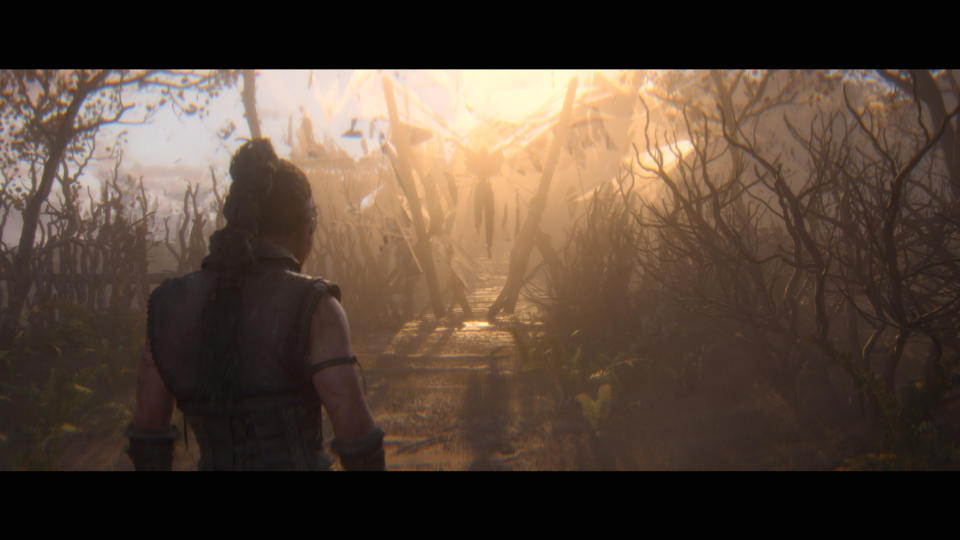
That theme is beaten into the ground, too, as Senua is routinely reminded that her “gift,” or the benefit of her condition, is the ability to see the world differently than others. Yet, in practice, there’s only ever one absolute solution to a puzzle that amounts to a binary switch. It may go against the heavy scripting mentality, but by offering no flexibility or opportunity to think outside the box beyond set parameters, the puzzle-solving of the game ends up doing a disservice to the theme as a whole.
The same goes for the combat which, although visually impressive, also feels like it’s been streamlined from what was already an extremely simplified setup. At specific points in the story, usually after a sudden ambush, the camera will tighten behind Senua as she draws her sword for what amounts to a series of one-on-one duels with individual warriors. Previously, Senua had about five moves including attack, heavy attack, kick, dodge, and block, on top of a focus move that slows the action down. This time, there’s even less as the kick has been omitted entirely, and enemies appear to have fewer types of moves, too. Most situations boil down to timing the block correctly, then unleashing hits until you can slow time down for more hits. Rinse, repeat.
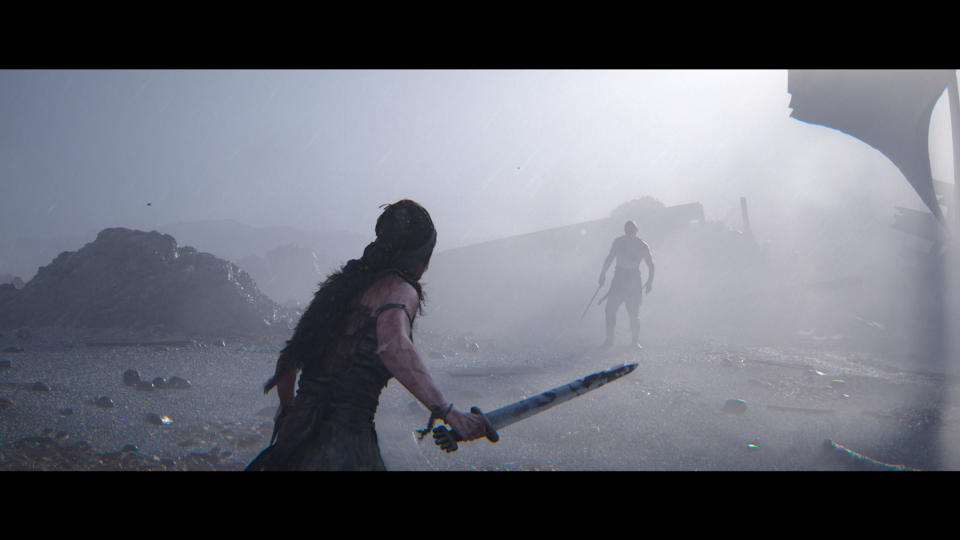
Boss fights, too, are now more about contextually racing toward a goal to cinematically handle the massive threat of the giants rather than squaring off in standard combat. Narratively, it makes sense. The game is about circumventing the need for violence to discover what’s ailing the giants in a more humanistic way, but it leaves the game feeling like it lost more features than it gained. The story may be more ambitious than its predecessor, but it feels like less of a game than a gamified audiovisual experience — a massive tech demo that even skips out on what most “movie-like” games lean into with choice-driven narrative and branching paths. There’s also a sense of cognitive dissonance as players are forced not to fight the big threats in lieu of a more sympathetic approach, while not extending the same mentality to the minions along the way.
So, if there’s barely any game to play and no storytelling decisions to make, what is there? The full weight of Senua’s Saga is predicated on its high-impact aesthetics and technological wizardry to carry players along for personal a fairy tale — which mostly works. But with less ambiguity to its story and a muddier focus on its recycled themes that often conflict directly with what the game is actually asking you to do, everything mostly amounts to diminishing returns.
As a glitzy haunted house ride with some light brain crunching, it works. If you can appreciate the earnestness of its storytelling, it’s a rarely seen optimistic slant on survival in a violent world. But if the developers are asking us to accept that humanity’s greatest struggle is with being their own worst enemy, perhaps it’s fair to ask why the game must be its own.
Senua’s Saga: Hellblade II is available now on Xbox Series X|S and Windows PC.
Best of Rolling Stone

